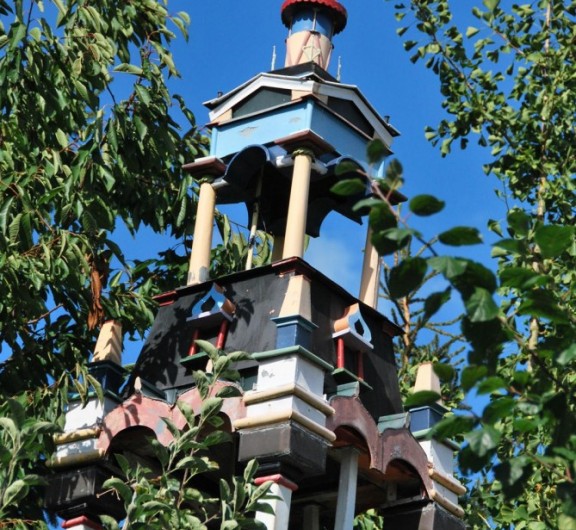Ruurd Wiersma, Four Seasons at the Ruurd Wiersma Hûs [Ruurd Wiersma House]
About the Artist/Site
Ruurd Wiersma was born in the small village of Rinsumageest in the Frisian countryside of the Netherlands. After completing his primary education, he began to work at a trade typical of those from this area: transporting milk from the dairy farms to the milk processing plant, a task made difficult due to the weight of the full cans. Although in his youth he fell in love, the young woman belonged to a different religious group, and her family forbade them to continue their courtship. Wiersma lived alone for the rest of his life.
Prior to the 1950s, he rented a house, but got into trouble with the landlord because of the still undocumented colorful scene that he painted on the wall behind a bird cage. He used the bird droppings and other objects to suggest a naturalistic environment, perhaps inspired by the Panorama Mesdag in The Hague. Subsequently, he purchased a small house dating from 1905 located alongside the canal that bisects the community of Burdaard.
The walls of Wiersma’s new home initially remained unpainted, but one day, in 1965, the oil stove in the living room exploded and all of the walls became covered with a thick layer of soot. In order to cover them and clean up, Wiersma covered the walls with paper, but he didn’t like the resulting whiteness of the walls, so he decided to decorate them.
From that time on, Wiersma demonstrated an impressive creativity that would last until his death some fifteen years later. The four walls inspired him to depict the four seasons, a project that took him about five years. He began with winter, which he displayed on a wall with three cabinet doors. This scene depicts a meadow with snow falling from a cloudy sky that spreads to also cover part of the ceiling. The painting of summer is on the wall against which stands the stove; it depicts a countryside scene and a seaside beach, full of activities. The other seasons also evoke Wiersma’s memories of the landscapes of his youth. A further scene, his impression of “the jungle of Africa,” was painted on the wall of the kitchen.
After Wiersma finished his Four Seasons, his neighbors encouraged him to continue to paint, and, indeed, from around 1970 until his death in 1980, he completed some 300 paintings. Most were painted with exterior enamel such as that used to paint bicycles, layered over a substructure of plywood or board, materials which – as they were fabricated to withstand the elements – have helped the paintings stand the test of time. (For example, two works that were used as decking in the attic of a house still are in satisfactory condition, apart from the various nail holes, and were donated to the house museum created after his death.) Unfortunately, however, the murals, with their unprepared surfaces, have remained vulnerable to the effects of moisture and thus require occasional restoration by professionals.
Wiersma concentrated on biblical scenes in his paintings; among the depictions were the Garden of Eden, Jonah and the Whale, Three Young Men in the Oven, Calvary, Balaam and the Donkey, and David in the Lion’s Den. He also created many paintings that evoke the Frisian landscape, scenes of daily life in Friesland, and special events, such as the Elfstedentocht, a renowned skating match almost 200 kilometers long, which passes by Burdaard as well as the eleven Frisian cities. Many of his paintings ended up in private collections; many he gave away, but most he sold, along with painted wooden shoes to tourists sailing the canal in front of his house.
With no immediate family, Ruurd Wiersma willed his home and some funds to the hospital that cared for him before he died. After his passing, the sense of his friends and art-lovers around Ruurd was that the house and its decorated interior should be preserved. In 1981 a private foundation was formed to do just that, and in 1982 it purchased the house from the hospital for a small and symbolic amount. Supported by a group of volunteers, the foundation currently runs the house as a museum. It is active in re-collecting and documenting Wiersma’s oeuvre, and in approaching potential funders to finance restorations and ensure the long-term stability and continuity of the site.
The museum, the Ruurd Wiersma Hûs [Ruurd Wiersma House], is open to the public during the summer months, April 1 through September 30; private viewings by appointment may be made during the rest of the year.
For more information: www.ruurdwiersma.nl
~Henk van Es
Contributors
Related Documents
Map & Site Information
6 Mounewei
Burdaard, Friesland, 9111 HA
Latitude/Longitude: 53.2954067 / 5.8801302
Extant
6 Mounewei, Burdaard, Friesland, 9111 HA
The museum, the Ruurd Wiersma Hûs [Ruurd Wiersma House], is open to the public during the summer months, April 1 through September 30; private viewings by appointment may be made during the rest of the year.
Nearby Environments









Post your comment
Comments
No one has commented on this page yet.